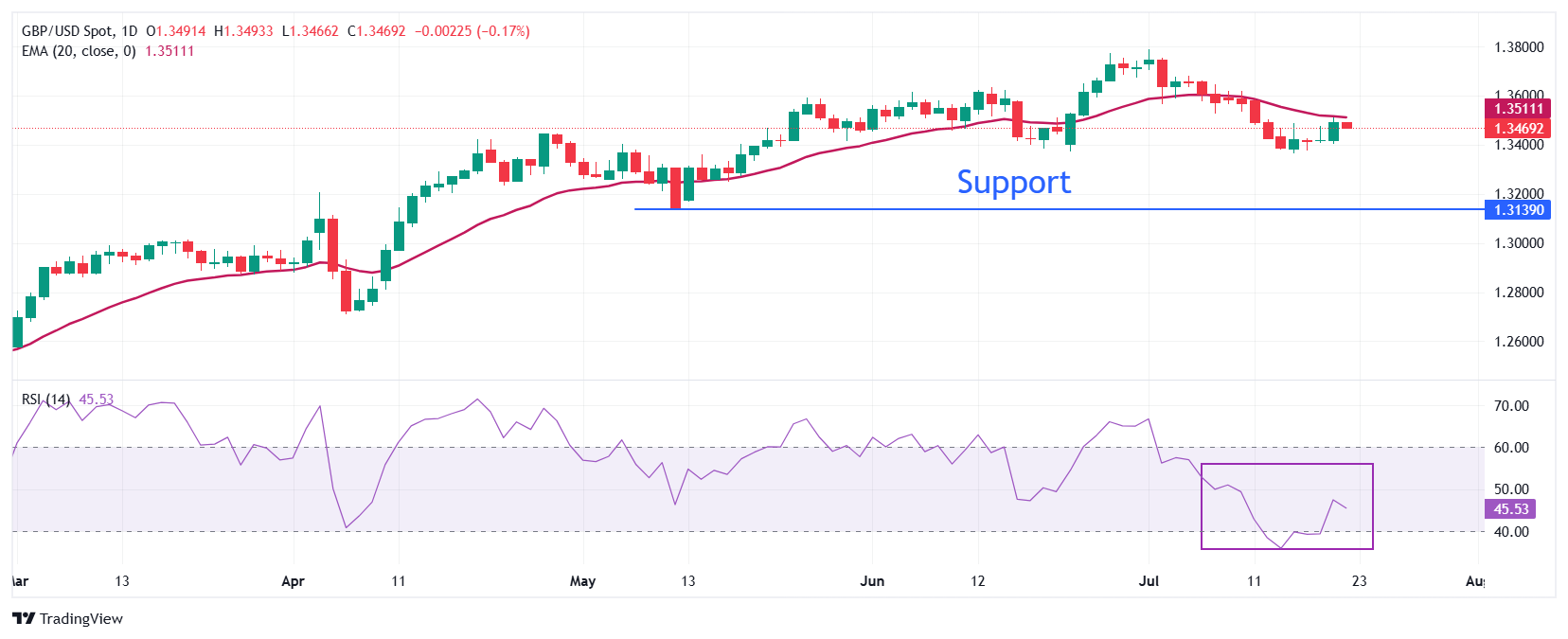Pound Sterling trades calmly against US Dollar as investors await updates on US tariffs
- The Pound Sterling consolidates around 1.3470 against the US Dollar, while investors await updates on US trade talks.
- US President Trump considers a higher tariff baseline rate on imports from the EU.
- Investors eye the flash US S&P Global PMI data for July.
The Pound Sterling (GBP) trades broadly sideways against the US Dollar (USD) around 1.3470 during the European trading session on Tuesday. The GBP/USD pair ticks down slightly as the US Dollar gains ground after Monday’s corrective move.
At the time of writing, the US Dollar Index (DXY), which tracks the Greenback’s value against six major currencies, finds cushion below 98.00. The DXY retraced from its four-week high near 99.00.
Investors brace for significant volatility in the US Dollar as United States (US) President Donald Trump’s August 1 tariff deadline is approaching and Washington has closed deals with a handful of nations. Also, the US is not expected to reach bilateral deals with its trading partners in the remaining time.
So far, the US has announced trade deals with the United Kingdom (UK), Vietnam and Indonesia, and a limited pact with China. Washington has sent letters, establishing tariff rates, to 22 nations, notably Japan, Vietnam, Canada, Mexico and the European Union (EU).
On Monday, US Treasury Secretary Scott Bessent signaled that Washington is more emphasized on “quality” and not “timing” regarding negotiations. “The important thing here is the quality of the deal, not the timing of the deals,” Bessent said in an interview with CNBC on Monday.
Meanwhile, fresh escalation in trade tensions between the US and the EU could weigh on the US Dollar. EU officials vow to retaliate against levies threatened by Trump. Over the weekend, a report from The Wall Street Journal (WSJ) signaled that the US president is considering a higher baseline tariff rate in a range between 15% and 20% from the 10% previously stated.
Daily digest market movers: Pound Sterling trades stably ahead of flash S&P Global UK PMI data
- The Pound Sterling demonstrates stability against its major peers on Tuesday, with investors awaiting preliminary United Kingdom (UK) S&P Global Purchasing Managers’ Index (PMI) data for July, scheduled for release on Thursday.
- Investors will closely monitor the UK PMI data to get cues about whether the impact of a hiring slowdown has started flowing into the economy. The report is expected to show that the overall business activity grew moderately. The Composite PMI is expected to have dropped slightly to 51.9 from 52.0 in June.
- UK employers have restricted fresh hiring to offset increased employee costs, following the effectiveness of an acceleration in employers’ contributions to social security schemes.
- Meanwhile, market expectations for the Bank of England’s (BoE) interest rate decision in the monetary policy announcement next month will be a key trigger for the Pound Sterling. The BoE is almost certain to cut interest rates by 25 basis points (bps) to 4%.
- In Tuesday’s session, investors will focus on BoE Governor Andrew Bailey’s testimony on July’s Financial Stability Report before the Treasury Select Committee at 09:15 GMT. Bailey is unlikely to provide guidance on the monetary policy outlook.
- In the US, traders have trimmed expectations for the Federal Reserve (Fed) to reduce interest rates in the September meeting.
- Traders pare Fed dovish bets after the release of the US Consumer Price Index (CPI) data for June last week, which showed that prices of products largely imported have increased after the imposition of sectoral tariffs by Donald Trump.
Technical Analysis: Pound Sterling wobbles below 1.3500

The Pound Sterling oscillates in the previous day’s range around 1.3470 against the US Dollar on Tuesday. The near-term trend of the GBP/USD pair is bearish as it faces selling pressure after a recovery move near the 20-day Exponential Moving Average (EMA) around 1.3500
The 14-day Relative Strength Index (RSI) strives to hold above the 40.00 level. A fresh bearish momentum would emerge if the RSI falls below that level.
Looking down, the May 12 low of 1.3140 will act as a key support zone. On the upside, the July 11 high around 1.3585 will act as a key barrier.
Pound Sterling FAQs
The Pound Sterling (GBP) is the oldest currency in the world (886 AD) and the official currency of the United Kingdom. It is the fourth most traded unit for foreign exchange (FX) in the world, accounting for 12% of all transactions, averaging $630 billion a day, according to 2022 data. Its key trading pairs are GBP/USD, also known as ‘Cable’, which accounts for 11% of FX, GBP/JPY, or the ‘Dragon’ as it is known by traders (3%), and EUR/GBP (2%). The Pound Sterling is issued by the Bank of England (BoE).
The single most important factor influencing the value of the Pound Sterling is monetary policy decided by the Bank of England. The BoE bases its decisions on whether it has achieved its primary goal of “price stability” – a steady inflation rate of around 2%. Its primary tool for achieving this is the adjustment of interest rates. When inflation is too high, the BoE will try to rein it in by raising interest rates, making it more expensive for people and businesses to access credit. This is generally positive for GBP, as higher interest rates make the UK a more attractive place for global investors to park their money. When inflation falls too low it is a sign economic growth is slowing. In this scenario, the BoE will consider lowering interest rates to cheapen credit so businesses will borrow more to invest in growth-generating projects.
Data releases gauge the health of the economy and can impact the value of the Pound Sterling. Indicators such as GDP, Manufacturing and Services PMIs, and employment can all influence the direction of the GBP. A strong economy is good for Sterling. Not only does it attract more foreign investment but it may encourage the BoE to put up interest rates, which will directly strengthen GBP. Otherwise, if economic data is weak, the Pound Sterling is likely to fall.
Another significant data release for the Pound Sterling is the Trade Balance. This indicator measures the difference between what a country earns from its exports and what it spends on imports over a given period. If a country produces highly sought-after exports, its currency will benefit purely from the extra demand created from foreign buyers seeking to purchase these goods. Therefore, a positive net Trade Balance strengthens a currency and vice versa for a negative balance.

